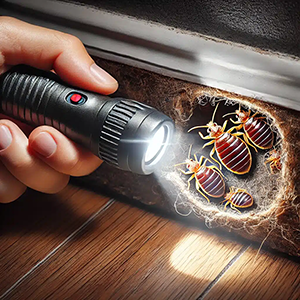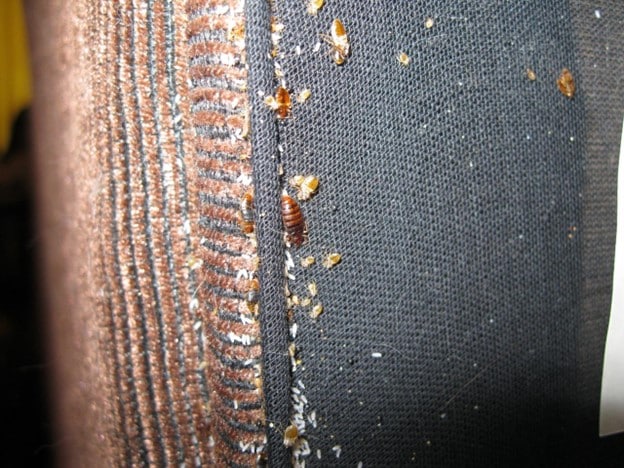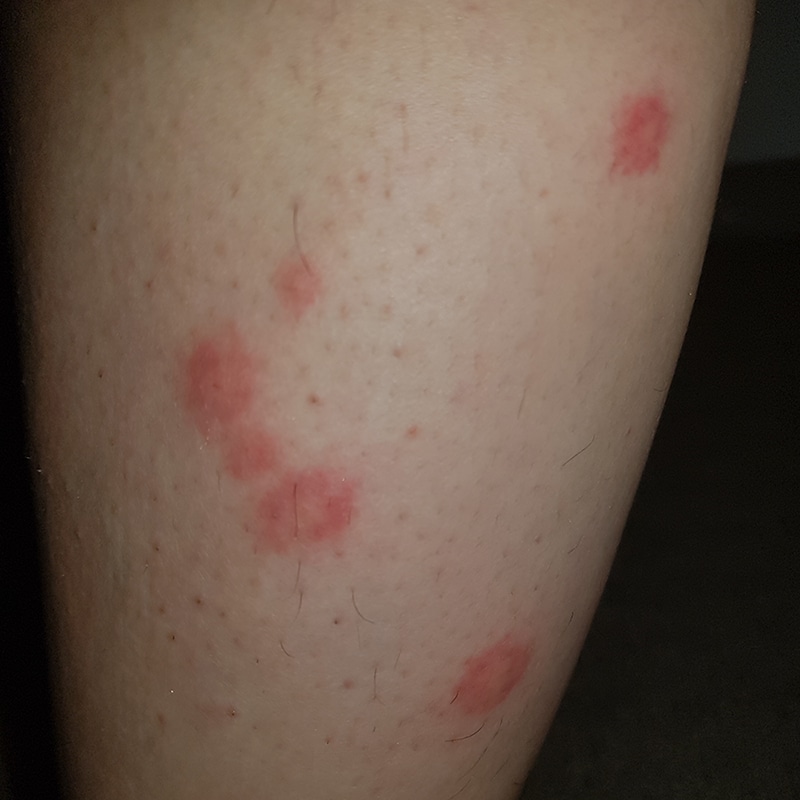
In the article
If you want to know how to check for bed bugs, then you need to know where they hide and what to look for. These sneaky critters are pros at hiding, so knowing their favourite and unexpected spots can make all the difference.
Common Bed Bug Hiding Spots
Bed bugs prefer to be as close as possible to their human hosts. Here are some of their top hideouts:
- Mattresses: They love the seams, piping and tags on mattresses and bases. Look for stains or discolouration here.
- Bed Frames and Headboards: Wooden bed frames and headboards are like luxury condos for bed bugs. They hide in the joints, cracks and crevices.
- Couches and Upholstered Furniture: They also cozy up in the seams and crevices of couches and other upholstered furniture.
- Cracks and Crevices Around Your Bed: Tiny cracks and crevices in wood trim, skirting boards, and moulding are perfect for bed bugs. Sealing these areas can help keep them out.
- Behind Wallpaper and Picture Frames: Loose wallpaper and picture frames offer a dark, secluded spot for bed bugs to hide.
- Light Fittings: Bed bugs can hide in the crevices around ceiling lights, lamps, and inside light fixtures. Check for small brown stains or live bugs by removing the light covers and inspecting inside.
- Under Carpet: Bed bugs often hide under the edges of carpets, especially where the carpet meets the wall. Lift the edges to look for dark fecal spots, eggs, or shed skins.
- Under Floorboards: The gaps between wooden floorboards are perfect hiding spots for bed bugs. Inspect these gaps for dark stains, eggs, or live bugs. You might need to remove a few boards to check thoroughly.
Unexpected Hiding Spots
Bed bugs don’t just stick to bedrooms. They can surprise you by hiding in less obvious places:
- Clothing and Linens: They can infest clothes and linens, especially if these are near infested areas. Regularly washing and drying these items on high heat can help get rid of them.
- Under Clutter: Bed bugs can hide under piles of clutter, so keeping your space tidy can help.
- Wall Voids and Electrical Outlets: They can hide in wall voids and behind electrical outlets, staying out of sight.
- Luggage and Bags: Bed bugs can hitch a ride on your luggage and bags, spreading to new places. Inspecting and cleaning your luggage after traveling can help prevent this.
- Books and Magazines: They can hide in the spines and pages of books and magazines, especially if these are near infested areas. Regularly checking and cleaning these items can help.

Bed Bug Nest on Mattress
Knowing where bed bugs hide can make it easier to find and control them. For more tips on spotting bed bugs, check out our guides on what do bed bugs look like and early signs of bed bugs.
Catching bed bugs early can save you a ton of headaches. Here’s how to spot these sneaky critters and check your mattress for any unwelcome guests.
Bed Bug Signs To Look For
Finding bed bugs means keeping an eye out for a few key signs. These tiny, blood-sucking insects are masters of hide-and-seek, but they do leave some clues:
- Live Bugs: They’re reddish-brown, about the size of an apple seed, and visible to the naked eye, including their eggs and baby bugs.
- Droppings: Look for tiny black or brown stains on your mattress and sheets—those are their droppings.
- Bloodstains: Sometimes, you might squash a bed bug in your sleep, leaving small red or rust-colored stains on your sheets.
- Shed Skins: As they grow, bed bugs shed their skins, which you can find near their hiding spots.
- Bites: Red itch marks anywhere on your body, but usually on the arms, legs, and shoulders.
Want more details? Check out our guide on what bed bugs look like.
Bed Bug Bites
Bed bug bites are a dead giveaway of an infestation. They usually show up in lines, clusters, or zigzag patterns on exposed skin like your face, neck, and hands. Unlike flea bites, bed bug bites don’t have a red spot in the center.
Reactions to these bites can vary. Some folks might not show any signs, while others could have severe allergic reactions. These bites can cause intense itching, sleepless nights, and anxiety.
For more on spotting bed bugs early, visit our article on early signs of bed bugs.
Bed bug bites can be mistaken for other insect bites, but their unique pattern and timing can help you identify them. To learn more about spotting these pests, check out our article on can you see bed bugs.

Bed Bug Bites
How to Get Rid of Bed Bugs On A Bed Frame
If you think you have bed bugs, don’t panic, we have the perfect bed bug treatment for you.
Follow these 3 easy steps to get rid of them fast and forever.
DIY Treatment For A Bed Frame
Step 1: Secure the Mattress
Cover your sleeping mattress with a mattress cover. This will trap and kill by starving them.
Step 2: Treat the bed frame
Use a Steamer to steam the entire bed frame to kill them instantly.
Dust the entire bed frame with Diatomaceous Earth (Killer powder) using a powder duster.
Step 3: Set Up Barriers or Tape
To protect yourself from bed bugs in the room, use our barriers:
Floor Barriers:
Place bed legs in the Floor Barrier, dusting powder inside the tray and barrier.
Barrier Tape:
For bed legs larger than 65mm, use our barrier tape and dust the powder around the bed leg and floor.
Keep your bed at least 30cm away from walls and other furniture.
How To Get Rid Of Bed Bugs On An Ensemble Bed
Step 1: Secure the Mattress
Cover your sleeping mattress with a mattress cover. This will trap and kill by starving them.
Step 2: Treat the Ensemble Base
Stand the base on its end, remove the wheels, and cover it with an ensemble base cover. Screw the wheels back into the base.
Step 3: Set Up Barriers
To protect yourself from bed bugs in the room, use barriers:
Screw-in Barriers: Attach the Screw in Barriers to the legs of the ensemble beds. Apply Kiler powder inside and outside the barriers and on the wheels.
Floor Barriers: Place bed legs in the Floor Barrier, dusting Killer powder inside the tray and barrier.
Keep your bed at least 30cm away from walls and other furniture.
Bed Bug Prevention Tips
7 Tips to Keep Bed Bugs Away:
1. Check Hotel Beds When Traveling. When you stay at a hotel, always look at the mattress and bedding. Look for tiny blood spots, dark poop stains, or little bugs.
2. After Traveling: When you get home, wash all your clothes in hot water and clean your luggage. If you can’t wash something, put it in a plastic bag and freeze it for four days to kill any bugs.
3. Avoid Second-Hand Furniture or Mattresses: Don’t bring old furniture or mattresses into your home. They might have bedbugs.
4.Use Diatomaceous Earth (DE): Put DE around power points and electrical outlets to stop bedbugs from getting in from other places.
5. Apply DE to Your Bed Frame: Putting DE on your bed frame is a great way to stop bedbugs because it keeps working until you clean it off.
6. Traveling Guests: If you have guests who have been traveling, wash their clothes in hot water and clean their luggage. They might accidentally bring bedbugs into your home.
7. New Housemates from Backpacker Hostels: If you have new housemates who stayed in backpacker hostels, wash their clothes in hot water and clean their luggage to keep bedbugs out.
Following these steps will ensure they are effectively eliminated from your bed and room, allowing you to sleep peacefully, knowing you’re protected. To find out more about our product check out our bed bug product page.
For more tips, visit our article on early signs of bed bugs.
Frequently Asked Questions About How To Check For Bed Bugs?
- How do you detect bed bugs?
To detect bed bugs, look for small blood spots, dark fecal stains, shed skins, and live bugs on your mattress, bedding, and furniture. You can also check for a musty odour. - Can you see bed bugs with the naked eye?
Yes, you can see bed bugs with the naked eye. Adult bed bugs are about the size of an apple seed (5mm), reddish-brown, flat, and oval-shaped. Nymphs (baby bed bugs) are smaller and lighter in colour, still visible but hard to see. - What are early signs of bed bugs?
Early signs of bed bugs include red, itchy bites on your skin, small blood spots on your sheets, dark fecal stains on your mattress and bedding, and finding live bed bugs or their shed skins in your sleeping area.
Sources:
Orkin (WHAT ARE SIGNS OF A BED BUG INFESTATION?)
Sleep Foundation (How to Check Your Mattress for Bed Bugs)



Leave a Reply